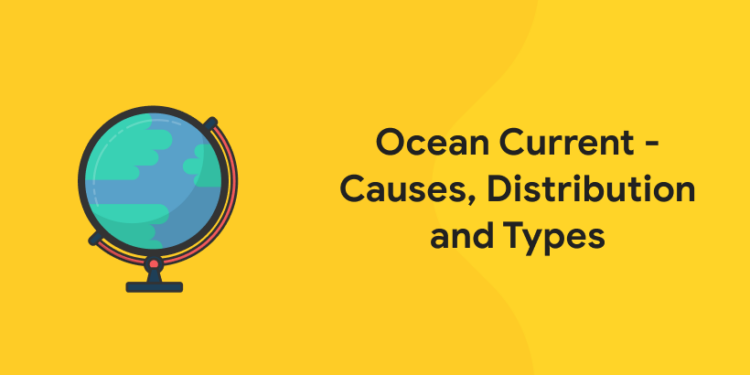Table of Contents
Oceanic currents can be described as the movement of water from one location to another. They are patterns of water movement and these patterns influence climate zones and weather patterns around the world. These currents are influenced by several forces that act to propel the water, both on the surface and in deep ocean waters.
Oceans distribute heat energy throughout the planet, thus regulating climate patterns and cycling of gases. Ocean currents influence the temperature of the region through which they travel.
Ocean currents are measured using units called Sverdrup (Sv) where 1 sv is equivalent to a volume flow rate of 1,000,000 m3 per second. They are also measured in meters per second or in knots (1 knot = 1.85 kilometers per hour or 1.15 miles per hour).
Attempt Free GK Mock Test! Download Entri App!
Causes of Ocean Currents
Ocean currents are caused by three main factors:
The rise and fall of tides: This movement of tides create a current in the ocean called tidal currents. They are strongest near the shore, in bays and estuaries along the coast.
Wind: Winds drive currents that are at or near the ocean’s surface. In the open ocean, winds drive currents that circulate water for thousands of miles throughout the ocean basins.
Water density differences: Different parts of the ocean has different temperature and salinity. This brings about a difference in the density of water thus causing currents at both deep and shallow ocean levels.
Ocean currents are also influenced by other factors like the shape and configuration of the ocean basin they flow through, rotation of the earth, gravity, earthquakes, storms etc.
Attempt Free GK Mock! Download Entri App!
Types of Ocean Currents
Ocean currents are classified into two depending on the layer of the ocean where they occur and the environmental factors that influence them. The two basic types of currents – surface currents and deep water currents.
Surface Currents
Surface currents refer to the movement of the top layer or surface layer of ocean water. It ranges from the surface to approximately 400 meters below the surface of the ocean. These currents are caused by the combined effect of wind, gravity, and the Coriolis Effect all of which determines the direction of the currents too. These currents cause both horizontal and vertical water movement. Horizontal surface currents are local and short term. They include rip currents, longshore currents, and tidal currents. The vertical movement pushes cold water towards the surface and less dense warm water downwards.
Wind has the greatest impact on ocean currents. As wind flows over the ocean surface, the friction between the air molecules and surface waters pushes the waters in the direction of the wind. It keeps flowing in the same direction until other factors influence its direction and speed, such as meeting a landmass or another ocean current. This impact will cause water to flow in different directions.
Gravity influences ocean surfaces depending on the differences in density which in turn is caused by differences in salinity and temperature of the water. Water is denser if it is colder and has high salinity. Denser water sinks below less dense water and gravity can influence the flow of currents. Ocean tides are also caused by the gravitational influence of the Earth, Moon, and the Sun. Due to the uneven surface of ocean water, gravity causes water to flow downward from higher surface level.
Ocean currents create circular patterns within the ocean due to barriers such as continents and the equator. These are called gyres. There are five significant gyres within the seas – the North and South Atlantic subtropical gyres, the North and South Pacific subtropical gyres and the Indian Ocean subtropical gyre. The Coriolis effect determines the direction and flow of the gyres. The gyres move clockwise in the Northern Hemisphere and anti clockwise in the Southern Hemisphere.
Deep Water Current
Deep water current refers to the movement of the water below the ocean’s surface. They arise due to the difference in water density. The cold dense water sinks and the less denser water flows to take it’s place. This causes a conveyor belt like effect of water circulating around the globe. This process is known as thermohaline circulation. This usually develops in extremely cold regions where the temperature of the air is low enough to make the surface water very cold, highly salty and more dense than the water beneath it. These currents differ in scale, speed, and energy. They are extremely cold and have high concentration of oxygen and salt levels.
Prepare for General Knowledge Exams! Download Entri App!
Distribution of Ocean Currents
Arctic Ocean |
| Baffin Island Current |
| Beaufort Gyre |
| East Greenland Current |
| East Iceland Current |
| Labrador Current |
| North Icelandic Jet |
| Norwegian Current |
| Transpolar Drift Stream |
| West Greenland Current |
| West Spitsbergen Current |
Atlantic Ocean |
| Angola Current |
| Antilles Current |
| Atlantic Meridional Overturning Circulation |
| Azores Current |
| Benguela Current |
| Brazil Current |
| Canary Current |
| Cape Horn Current |
| Caribbean Current |
| East Greenland Current |
| East Iceland Current |
| Equatorial Counter Current |
| Falkland Current |
| Florida Current |
| Guinea Current |
| Gulf Stream |
| Irminger Current |
| Labrador Current |
| Lomonosov Current |
| Loop Current |
| North Atlantic Current |
| North Brazil Current |
| North Equatorial Current |
| Norwegian Current |
| Portugal Current |
| South Atlantic Current |
| South Equatorial Current |
| West Greenland Current |
| West Spitsbergen Current |
Indian Ocean |
| Agulhas Current |
| Agulhas Return Current |
| East Madagascar Current |
| Equatorial Counter Current |
| Indian Monsoon Current |
| Indonesian Throughflow |
| Leeuwin Current |
| Madagascar Current |
| Mozambique Current |
| North Madagascar |
| Somali Current |
| South Equatorial Current |
| Southwest Madagascar Coastal Current |
| West Australian Current |
Pacific Ocean |
| Alaska Current |
| Aleutian Current |
| California Current |
| Cape Horn Current |
| Cromwell Current |
| Davidson Current |
| East Australian Current |
| East Korea Warm Current |
| Equatorial Counter Current |
| Humboldt Current |
| Indonesian Throughflow |
| Kamchatka Current |
| Kuroshio Current |
| Mindanao Current |
| Mindanao Eddy |
| North Equatorial Current |
| North Korea Cold Current |
| North Pacific Current |
| Oyashio Current |
| South Equatorial Current |
| Subtropical Counter current |
| Tasman Front |
| Tasman Outflow |
Antarctic Ocean |
| Antarctic Circumpolar Current |
| Tasman Outflow |
The key point to clear an exam lies in methodical and planned preparation. If you are a candidate who wants to pursue your dream career and looking for a good start, Entri App has got it covered for you. Entri App provides a great online platform for all those aspiring to appear for various bank exams, government exams and other competitive exams. Our team of experts provide short and precise video classes which helps in learning the concepts. Users get access to flash cards and quizzes and can attempt unlimited mock exams with the same pattern as that of the real exams. We also provide PDFs of previous years’ question papers with solutions.
Attempt Free Mock Tests for General Knowledge Exam! Download Entri App!













